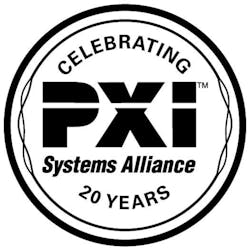Incoming and outgoing presidents chart past and future of PXI Systems Alliance
Courtesy of Marvin Test Solutions
NATIONAL HARBOR, MD—The PXI Systems Alliance is celebrating its 20th anniversary. At its annual meeting in September at AutoTestCon, the organization touted 67 member companies, with PXI product sales worldwide nearing $1 billion. AutoTestCon also marked the formal handover of the role of PXISA president from Loofie Gutterman, president and founder of Marvin Test Solutions (formerly Geotest-Marvin Test Systems) to Bob Stasonis, director of sales and marketing at Pickering Interfaces.
In an interview at AutoTestCon, Gutterman and Stasonis commented on the origins and growth of the PXISA and future plans. They noted that coincidentally, both their companies are also celebrating key anniversaries this year: Marvin Test Solutions1 and Pickering Interfaces are both 30 years old, and Pickering Interfaces’ sibling company Pickering Electronics is celebrating 50 years of designing and manufacturing reed relays.2
Courtesy of Pickering Interfaces
Both Gutterman and Stasonis have been involved in PXI from early on. They noted National Instruments introduced its first PXI product line in 1997,3 opening up PXI as a standard and inviting other companies to build PXI products, with the PXISA forming in 1998. Early participants included GenRad (later purchased by Teradyne), where Stasonis worked at the time; Pickering Interfaces; PXIT (no longer in business); and Geotest-Marvin Test Systems.
PXI presented challenges from both a technology and marketing perspective. Initially, Gutterman noted, PXI products were 3U-only. “3U was a major limitation for us,” he said, adding that the company could not effectively deploy the functionality of its high-end digital instruments within the 3U form factor. “We knew there was a 6U provision in the standard,” he said, “but we didn’t want be the only company building 6U PXI products.” Fortuitously, GenRad soon introduced 6U PXI products, and a few months later Geotest-Marvin Test Systems followed with 6U PXI instruments and chassis. The company makes many 3U PXI products today, Gutterman said, but if the choice is a single-slot 6U instrument vs. a multislot 3U instrument, the company will choose the 6U form factor. “GenRad showed us we’re not alone,” he said. Subsequently, Geotest-Marvin Test Systems shifted its instrumentation R&D dollars to PXI.
“PXI 101”
Geotest-Marvin Test Systems and GenRad subsequently collaborated on marketing the technology. “We teamed up with GenRad to present ‘PXI 101’ seminars,” Gutterman said. “We did more ‘Introduction to PXI” seminars between the two of us than did any other members of the alliance.” According to Stasonis, the alliance itself in its early days lacked the funding to mount such initiatives.
“We talked about products a little bit, but most of the presentations were about PXI—what it brings to the table and why people should seriously consider it for test equipment,” said Gutterman. “All we asked was for them to consider it as one of their options for their next platform.”
Gutterman and Stasonis agreed that the collaboration between the companies in promoting PXI was enhanced by the minimal competition between the two—GenRad focused mostly on commercial applications, while Geotest-Marvin Test Systems focused on military/aerospace applications. But the companies did have some similarities that supported their efforts to drive PXI technology forward. “GenRad had their own instruments and did system integration, and we had our own instruments and did system integration,” Gutterman said. “That’s why the collaboration made a lot of sense—because we were very similar companies.”
In any event, “The goal was to promote PXI—it was not to sell products, but to sell the concept,” said Gutterman. “Because in the beginning we had to fight for business.”
Part of that fight was to get VXI customers to consider PXI technology. Stasonis said that in the early AutoTestCon events after PXI’s introduction, you would see few PXI products on the exhibit floor—companies predominantly displayed VXI chassis and instruments. Gutterman said that VXI proponents would contend that PXI was suitable only for low-end data-acquisition applications.
Fighting back
PXI proponents fought back in subsequent AutoTestCon shows with the introduction of “no holds barred” PXI vs. VXI panels. These events were standing-room-only, Gutterman and Stasonis said, perhaps because of the occasional outrageous claims of some participants. Nevertheless, the events succeeded in prompting attendees to consider PXI’s possibilities.
As time progressed, the PXISA took on more responsibilities for promoting the standard and related products. After the formation of the group, new members could join at a lower level and subsequently assume the top “sponsor-level” membership—available to companies producing more than one or two products and demonstrating a willingness to make a major investment to promote the standard.
One initiative included holding interoperability sessions at AutoTestCon to dispel criticisms that PXI wasn’t really a standard and that PXI products don’t play well together. At the interoperability sessions, Gutterman said, PXI vendors would bring their gear. “We put our cards in their chassis, and they put their cards in our chassis, and you put multiple cards from multiple vendors into any chassis, and we demonstrated that everything was working,” he said. “We did that for many years.”
PXI evolution
The PXI standards have evolved over the years, notably with the introduction of PXI Express, or PXIe. As with the decision to whether to use 6U or 3U instruments, Gutterman said, the choice between PXI and PXIe depends on the application. According to Gutterman, “Some companies have abandoned PXI in favor of PXI Express, and there are products where you need PXI Express, but we think PXI is still viable.”
According to Stasonis, “With many switching applications working in milliseconds, PXIe is not worth the expense.” Of course, many switching applications do require higher performance, and Pickering at this year’s AutoTestCon exhibited a new PXIe version of its USB 2.0 Hub module. The new Model 42-738 single-slot 3U PXIe module combines an 8-port USB 2.0 hub and USB data/power switching to provide a controlled connection between the backplane and USB products. Each port can connect and disconnect the power and data paths separately, simulating various connection faults. The module can be used to connect a USB device under test or USB test equipment to the test system without reliance on the controller’s USB ports, eliminating the need for freestanding powered hubs in a test system. Gutterman added that to date, all his company’s PXI Express products are also available in PXI. “If you want to do continuous streaming at high speed, you may need the PXI Express version,” he said. “If you don’t, then you can save money and use the PXI.” He added that the company is currently developing a product whose bandwidth is such that it requires PXI Express. But in general, he said, “We are not trying to force customers into migrating from PXI to PXI Express—they can use what they want.” Added Stasonis, “It’s all about the application—use what fits best, absolutely.”
PXI continues to evolve. Stasonis pointed out that six of seven PXI specifications have been revised over the past year. And over the next year, “There are going to be some software changes,” Gutterman said. “We are working to improve interoperability.”
“We update everything to keep up with the times,” Stasonis added.
In addition to interoperability, Gutterman and Stasonis cited viability and backwards-compatibility. With regard to the latter, Stasonis said, “I can take a 20-year-old PXI switch and put it in a hybrid chassis and it will work.” Longevity is particularly important for military/aerospace customers, he added, who expect support for 20 years or more.
PXI has made significant inroads in military/aerospace applications, and AutoTestCon has been a key venue for promoting the technology. Gutterman and Stasonis cited the U.S. Air Force PATS-70A (Portable Automated Test Set) and Bomber Armament Tester (BAT) as among the many military/aerospace systems employing PXI technology.
Both these systems have been in the news recently. For example, in May Pickering Interfaces announced that the U.S. Air Force, Ogden Air Logistics Complex at Hill AFB, Utah, recently awarded the company a contract for a large quantity of 6U high-density matrix modules to meet the PATS-70A PXI switching requirement for O-Level and I-Level maintenance of A-10C aircraft.4 The contract calls for Pickering Interfaces to provide Model 45-542 PXI switching matrix modules for more than 100 PATS-70A systems. The company said this is Pickering’s second such order for matrix modules, as it worked with Hill AFB on deployment of the PATS-70 test set in 2014. The PATS-70A program will enhance the capabilities of the PATS-70 test set to support additional armament and weapon systems in addition to supporting the existing avionics test functionality.
In addition, Marvin Test Solutions announced at the beginning of the year that the company is a member of the BAE Systems-led team that won the U.S. Air Force BAT program competition in September 2017.5 The BAT will be the U.S. Air Force’s common armament tester for the B-1B, B-2A, and B-52H, supporting flightline and intermediate-level testing of all bomb ejector racks, rotary launchers, and pylon assemblies used by the nation’s bomber fleet. MTS will be a significant provider of hardware, software, and design support for the BAT Core Tester.
Beyond MIL/aero
Nevertheless, Gutterman and Stasonis pointed out, PXI is finding use in application areas including medical, automotive, and 5G. Said Gutterman, “If you talk to the CEOs of semiconductor companies, they talk about reducing the cost of test. PXI can help reduce both the cost of test and the footprint of test without compromising specifications.”
After 15 years, Gutterman is wrapping up his role as PXISA president and is transferring the responsibilities to Stasonis, who said the new role is compatible with his shifting responsibilities within Pickering Interfaces to assume a more outgoing focus on market presence. Commenting on his tenure as PXISA president, Gutterman said, “I enjoyed it—it was a lot of fun.” Added Stasonis, “We’ll keep him active—don’t worry, he’ll still be involved.”
Indeed, Gutterman is continuing as a member of the PXISA board of directors, and Marvin Test Solutions will continue to be heavily invested in PXI technology, he said. On a related note, Stasonis said 70% of Pickering Interfaces business is in PXI. The two companies being major players in the PXI marketplace, Gutterman commented, indicates that “you don’t need to be an 800-lb. gorilla to make an impact.” EE
References
- “Marvin Test Solutions marks 30 years in the test and measurement industry,” EE-Evaluation Engineering Online, Sept. 12, 2018.
- “Pickering Electronics celebrates 50 years of reed relays,” EE-Evaluation Engineering Online, Jan 29, 2018.
- Earls, Alan, “20-year PXI development has seen continued growth,” EE-Evaluation Engineering, May 2017.
- “PXI switching module selected for A-10C aircraft ground support,” EE-Evaluation Engineering Online, May 3, 2018.
- “U.S. Air Force awards Bomber Armament Tester contract to BAE Systems and Marvin Test Solutions team,” EE-Evaluation Engineering Online, Jan. 3, 2018.
About the Author

Rick Nelson
Contributing Editor
Rick is currently Contributing Technical Editor. He was Executive Editor for EE in 2011-2018. Previously he served on several publications, including EDN and Vision Systems Design, and has received awards for signed editorials from the American Society of Business Publication Editors. He began as a design engineer at General Electric and Litton Industries and earned a BSEE degree from Penn State.


